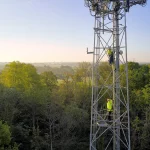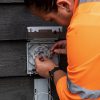EE UK to Trial New Content Delivery Network Tech with TV Services

Broadband ISP and mobile operator EE are preparing to trial delivery of their TV content via a new Content Delivery Network (CDN) technology in the “coming months“, which reflects BT’s effort to integrate their “world’s first” MAUD (Multicast-Assisted Unicast Delivery) solution into Edgio’s CDN.
Most broadband and mobile operators use sophisticated Content Delivery Networks and systems to help manage network load, which caches popular internet content closer in the network to end-users (i.e. improves performance without adding network strain). Such systems also help to lower the provider’s impact on external links and keep bandwidth costs down.
In case anybody has forgotten, BT first talked about their new IP transmission technology, called MAUD, back in December 2023 (here). Unlike traditional “unicast” delivery methods, where each broadband connected viewer watches the action via a dedicated, personal internet stream, MAUD uses “multicast” to group those single streams into one shared one, directing it to those that want to watch the action.
Advertisement
The new technology’s integration is also made completely transparent to the player application, which means content service providers (BBC, Netflix etc.) don’t need to modify their customer apps to take advantage of it (i.e. saving time and money). BT previously claimed that its MAUD technology uses up to 50% less bandwidth during peak events and reduces energy usage through the use of fewer caches.
Howard Watson, Chief Security and Networks Officer at BT Group, said:
“BT Group’s goal is to develop an efficient live streaming solution that addresses the needs of players within the content delivery path. Partnering with Edgio, we’re pioneering an effective content delivery system that seamlessly integrates with CDNs, making it accessible for external content providers”.
Suffice to say that it makes perfect sense for the operator’s first live network trials of this technology, alongside Edgio’s CDN, to involve some of EE’s TV customer and their set-top-boxes. BT Group will also be showcasing MAUD at the International Broadcasting Convention (IBC) 2024, taking place 13-16 September in Amsterdam.
Admittedly, from the consumer’s perspective, this is one of those seamless changes where if it’s working correctly then you probably won’t even notice it’s there. On the other hand, anything that helps to reduce network congestion is likely to result in more customers receiving higher quality streams.
Sadly, at the time of writing, we still don’t know exactly when these trials will take place or how many customers will be involved.
Advertisement
Mark is a professional technology writer, IT consultant and computer engineer from Dorset (England), he also founded ISPreview in 1999 and enjoys analysing the latest telecoms and broadband developments. Find me on X (Twitter), Mastodon, Facebook, BlueSky, Threads.net and Linkedin.
« Rural Coalition Reiterates Concerns Over 4G Mobile Rollout to UK Gov






















































If you’re on the same PON as a neighbour and both watch the same live broadcast, would only one signal be sent down the fibre? Or is it not that clever?
Not quite that clever. One Multicast feed into the Openreach head end is then replicated by the Openreach switch to the customers, keeping traffic off the link from ISP into Openreach. If two FTTC customers from the same ISP are on the same cabinet, the cabinet will do the multicast replication, keeping traffic off the cabinet’s connection to the Openreach head end.
They should think again about NETGEM.TV solution! Best relation quality/price, with game streaming!
Sorry, how is this connected to netgem?
Ben,
Some years ago, EE had Netgem.TV.
Then changed to worst tv offer.
EE TV is a good service. Picture quality in internet mode is so much better than the poor freeview. However they are really lagging behind with the number of available channels. Even some of the basic freeview channels are not available. Especialy the channels from U.
Not difficult for the picture quality to be better than Freeview as Freeivew is an awful service. If Freely become the norm, picture wise it should be better than Freeview, the problem is relying on broadband to get your TV.
i do that anyway as I don’t use Freeview, I don’t have a TV licence, so everything I watch is either streaming or optical disk. But i am not that bothered if it goes belly up, I will just read a book.
To be honest, i thought by now there would be a better system to stream by now, Unicast have been around for a while.
Totally disagree freeview is a good service, I too have ee tv,and I agree the picture quality is good over the Internet,but there is no perceived difference between that or freeview over the air, at least not on my tv. I would suggest the problem may be with your aerial. EE tv over the Internet is a slimmed down version of freeview minus a lot of over the air channels.
I wonder what the barrier is to just going full multicast. From what I understand, IPv6 was built with multicast capabilities in mind and it makes a tonne of sense in the streaming world, especially for live events.
It’s the end devices, they all have to support multicast, which is a massive barrier with 1000s of different devices of different ages. This approach hides the multicast and turns it back into unicast in the home (on the router in the home) to provide to the end device as if it was always unicast.
Live channels already are delivered with multicast (and over v4 even).
To my knowledge this is for events and content streamed through other platforms (Prime, iPlayer, etc) with supporting CDN partners
Live channels are delivered at a single bit rate using a single container to a set top box over multicast as they need control over the end device. This allows their delivery more efficiently to a variety of end devices at different bit rates and in different containers.
4 months in from BT to EE migration and not able to PAIR router to account so NO WiFi controls contrary to the £million adverts..
Does this only work with TV content or is it also being used for new game releases and updates to consoles etc?
MAUD is data-agnostic, so whilst the initial focus is on streaming I see no reason why this technology cannot be applied to other types of deliveries such as game releases and updates to consoles.
Only TV
Yes, only linear TV.
Game and firmware updates are pulled on demand by each machine as each one will download at a different rate. Need to be sending the same data to different customers served by the same resources at exactly the same time to make any multicasting worthwhile.
So this needs sudofed software running in the router.
Unless its standard based I guess I’ll be without this as I run opnsense.
No. Router just needs to be able to handle multicast. Speaking IGMP should be fine, the MAUD proxy can live inside the LAN.